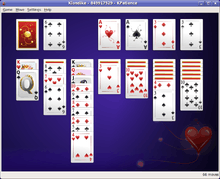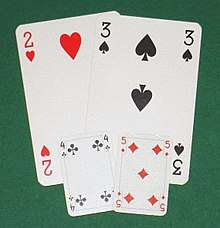Patience (game)
Patience (Europe), or solitaire (US/Canada), is a genre of card games that can be played by a single player. Patience games (also called patiences) can also be played in a head-to-head fashion with the winner selected by a scoring scheme.
Name
'Patience' is the earliest recorded name for this type of card game. The word is French in origin, these games being "regarded as an exercise in patience."[1] Although the name solitaire became common in North America for this type of game during 20th century, Parlett notes that a good reason for preferring 'patience' to 'solitaire' is that any game of patience may be played competitively by two or more players.[1] In practice, although the term 'solitaire' refers to any one-player game, including board games, in North America it is often used totum pro parte to refer specifically to one-player card games, although sometimes the term card solitaire is used for clarity. Meanwhile in other countries 'solitaire' specifically refers to the board game of peg solitaire. Both 'solitaire' and 'patience' are also sometimes used to refer specifically to the game of Klondike.
Overview
The game generally involves manipulating a layout of cards with a goal of sorting them in some manner. It is possible to play the same games competitively (often a head to head race) and cooperatively.
Patience games typically involve dealing cards from a shuffled deck into a prescribed arrangement on a tabletop, from which the player attempts to reorder the deck by suit and rank through a series of moves transferring cards from one place to another under prescribed restrictions. Some games allow for the reshuffling of the decks, or the placement of cards into new or "empty" locations. In the most familiar, general form of patience, the object of the game is to build up four blocks of cards going from ace to king in each suit, taking cards from the layout if they appear on the table.
There is a vast array of variations on the patience theme, using either one or more decks of cards, with rules of varying complexity and skill levels. Many of these have been converted to electronic form and are available as computer games. The inclusion of Klondike Solitaire with Microsoft Windows from 1990 onward had an especially big impact in popularizing solitaire with the general public.[2]
History
The game is thought to be German or Scandinavian in origin.[3] The game became popular in France in the early 19th century, reaching Britain and America in the latter half. The earliest known recording of a game of patience occurred in 1788 in the German game anthology Das neue Königliche L'Hombre-Spiel.[4] Before this, there were no literary mentions of such games in large game compendiums such as Charles Cotton's The Compleat Gamester (1674) and Abbé Bellecour's Academie des Jeux (1674).

Patience was first mentioned in literature shortly after cartomantic layouts were developed circa 1765, suggesting a connection between the two. This theory is supported by the name of the game in Danish and Norwegian, kabal(e). An 1895 account describes a variant of the game exclusively used for cartomancy.[3]
The first collection of patience card games in the English language is attributed to Lady Adelaide Cadogan through her Illustrated Games of Patience, published in about 1870 and reprinted several times.[5] Other collections quickly followed such as Patience by Ednah Dow Littlehale Cheney (1869),[6] Amusement for Invalids by Annie B. Henshaw (1870),[7] and later Dick's Games of Patience, published by Dick and Fitzgerald.[8] Other books about patience written towards the end of the 19th century were by H. E. Jones (a.k.a. Cavendish), Angelo Lewis (a.k.a. Professor Hoffman), Basil Dalton, Ernest Bergholt, and Mary Whitmore Jones.
Types
Patience games are commonly grouped together according to family, where related games such as Klondike games, Forty Thieves games, or Matching games are classified together. David Parlett instead adopts a system of classification based on the amount of information available about the cards at the start of the game (closed, open, or half-open), and based on the process of manipulating the cards (building, or packing).
In most games of patience the overall aim is to arrange all thirteen cards of each suit in order in a "family" running from ace to king. Normally the ace forms the "foundation" on which a two of the same suit is placed, followed by a three and so on. This is known as "building" and all such games are, technically, builders. However, in many games the cards must be assembled in reverse order on another part of the layout called the "tableau". They can then be built in the right sequence on the foundations. This interim process of reverse building is called "packing", and games that use this technique are thus called "packers". Games that use neither technique are called "non-builders".[9] There are also specials kinds of packer games which may be further sub-classified as 'blockades', 'planners' and 'spiders'.[9]
Patience games may be classified by the degree to which the cards are revealed. In "open" games, all the cards are visible throughout the game and the player has to use powers of analysis to solve the patience. In "closed" games, cards are drawn from a face-down stock and the player has to use judgement because the sequence of cards is unknown until they appear. In between is a hybrid group which Parlett calls "half-open".[10]
Closed games
Closed games are those in which, throughout the game, not all the cards are visible. They require more judgment because the sequence of cards is unknown. As cards appear, if they cannot be played straight away they are put into a wastepile from which they may, potentially, not be accessible again. Closed games may be subdivided into the following categories:[11]
- Simple builders. Typically the aim of a simple builder is to build cards in suit sequence on the Aces which form the foundations. They are 'simple' in that the player has little or no choice in playing and just needs to watch for opportunities to build, any card that cannot be built being discarded to a wastepile where it may, of course, become inaccessible. Cards may be played from the wastepile or the hand and when the hand cards are exhausted it may be possible to 'redeal' by playing through the wastepile, usually for a limited number of times.
- Reserved builders. An elaboration of the simple builder is to deal a number of cards to a 'reserve', thus increasing the number of cards available to play.
- Simple packers. Packers enable cards to be built in reverse sequences on the layout - sometimes called 'auxiliary sequences', before playing them to the foundations in the correct sequence. Building in reverse sequence is known as 'packing'.
- Reserved packers Reserved packers combine the features of having a reserve of cards and also the ability to pack in reverse sequence before laying off to the foundations.
- Non-builders The aim of a non-builder is not to build suit sequences, but some other objective. In many of them the aim is to discard the entire pack or packs by pairing cards of the same rank or adding up to a given number.
Open games
In open games, the entire pack of cards is visible at the outset and continue to be visible throughout the game. These games require careful analysis (as in chess) to achieve success. Open games may be divided into the following categories:[11]
- Open builders. A family of builders in which all the cards are faced at the start of play.
- Open packers. Likewise a family of packers in which all the cards are visible at the outset.
- Open non-builders. A branch of open patiences in which the aim is other than build suit sequences.
Half-open games
Half-open games are those which start 'closed' and become 'open' as the game progresses. They may be divided into:[11]
- Half-open builders. These are games where the aim is to build up suit sequences without the help of packing in reverse order first. Unlike simple builders, there is no wastepile, but cards are added to the layout if they cannot be built until the game reaches a point where all the unbuilt cards are visible and the game becomes one of analysis.
- Blockades. A small family of builders named after British Blockade in which the cards are only available if there is no card below (or sometimes above) it.
- Planners. A large family of builders with a high skill level. Cards are played to the foundations or to several wastepiles, the top cards of which are always available to play.
- Half-open packers. These are packers where, during the course of the game, all the remaining cards eventually become visible.
- Spiders. A small family of games named after Spider Solitaire in which all the building takes place on the tableau and not to separate foundations.
See also
- List of patience games
- List of software patience games
- Glossary of Patience terms, not including peg solitaire.
- Patience sorting, a computer algorithm
References
- Parlett 1991, pp. 157-161.
- "The Three Most Played Solitaire Card Games in the World". Retrieved 30 June 2020.
- Parlett, David. "Patience". Historical Card Games. David Parlett. Retrieved 7 January 2016.
- (Anon.) (1788). Das neue königliche l'Hombre … (in German) (12th ed.). Hamburg, (Germany): Herold. pp. 173–174.
- Cadogan, Adelaide (1874). Illustrated Games of Patience. London, England: Sampson Low, Marston, Low, and Searle.
- Cheney, Ednah Dow Littlehale (1869). Patience: A Series of Games with Cards (2nd ed.). Boston, Massachusetts, USA: Lee and Shepherd.
- Henshaw, Annie B. (1870). Amusement for Invalids. Boston, Massachusetts, USA: Loring.
- Dick, William Brisbane, ed. (1883). Dick's Games of Patience, or, Solitaire with Cards …. New York, New York, USA: Dick & Fitzgerald.
- Parlett 1979, p. 19.
- Parlett 1979, p. 22.
- Parlett 1979, pp. 7-9.
Bibliography
- Arnold, Peter. Card Games for One. London: Hamlyn, 2002 (ISBN 0-600-60727-5)
- Bergholt, Ernest (1941). A New Book of Patience Games. Routledge.
- Blanccoeur, Comtesse de (1860-70). Le Livre Illustré des Patiences. Brussels.
- Cadogan, Lady Adelaide (1870). Illustrated Games of Patience.
- "Cavendish" (= Henry Jones) (1890). Patience. De La Rue.
- Crépeau, Pierre. The Complete Book of Solitaire (a translation of Le Grand Livre des Patiences). Willowdale, Ontario: Firefly Books, 2001. (ISBN 1-55209-597-5)
- Dalton, Basil (1948). The Complete Patience Book. John Baker.
- Harbin, Robert (1972). Waddington's Family Card Games. Pan, London.
- Hoffmann, Professor (= Angelo Lewis) (1920). Illustrated Book of Patience Games. Routledge. English translation of Blanccoeur.
- Lee, Sloane & Packard, Gabriel. 100 Best Solitaire Games: 100 Ways to Entertain Yourself with a Deck of Cards. ; New York, N. Y.: Cardoza Publishing, 2004. (ISBN 1-58042-115-6)
- Marks, Arnold & Harrod, Jacqueline. Card Games Made Easy. Surrey, England: Clarion, 1997 (ISBN 1-899606-17-3)
- Morehead, Albert and Geoffrey Mott-Smith (1950). The Complete Book of Patience. Faber & Faber.
- Morehead, Albert H. and Geoffrey Mott-Smith. The Complete Book of Solitaire and Patience Games. New York: Bantam Books, 1977 (ISBN 0-553-26240-8)
- Parlett, David (1991). A History of Card Games, OUP, Oxford. ISBN 0-19-282905-X.
- Parlett, David (1979). The Penguin Book of Patience, Penguin, London. ISBN 0-7139-1193-X
- Phillips, Hubert (1960). The Pan Book of Card Games. Pan, London.
- Whitmore Jones, Mary. Games of Patience, Series 1-5 (1899) – New Patience Games of Patience (1911), Upcott Gill, London.
External links
| Wikimedia Commons has media related to Solitaire. |
| Wikibooks has a book on the topic of: Solitaire card games |
- Lady Cadogan's Illustrated Games of Solitaire or Patience, by Adelaide Cadogan, 1914, from Project Gutenberg
- Games of patience for one or more players, second series, by Mary Whitmore Jones, about 1898, original book-scan from Archive.org
- . Encyclopædia Britannica (11th ed.). 1911.

